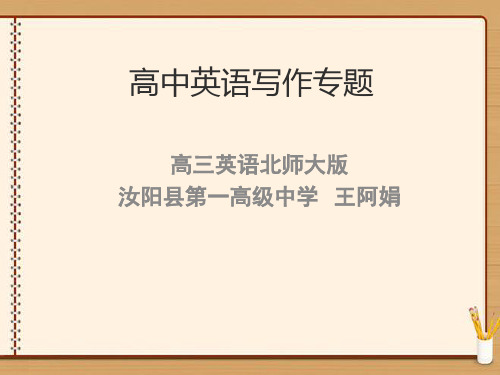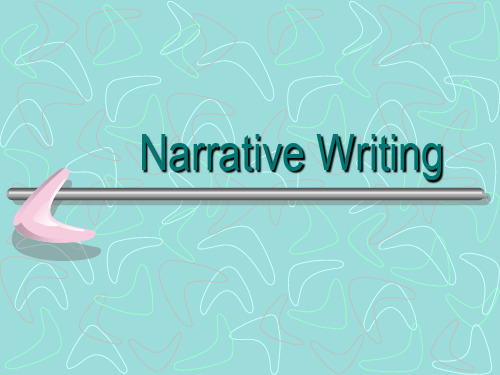2020年高级英语写作课件
合集下载
2020版高考英语复习名师写作辅导课件:写作技巧大全 (共129张PPT)

考法1 应用文
·I would like to know some information on… ·It will be appreciated if you can/could… ·I would also like to know if you can/could… ·Please give my best regards to… ·Remember me to your parents.
1. 展览时间、地点; 2. 展览内容。 注意:1. 词数100左右;
2. 可以适当增加细节,以使行文连贯。 ____________________________________________
____________________________________________
例
[课标全国Ⅱ2017]
The exhibition is a collection of works including some papercuts from famous artists. Among the papercuts will be some works from us students. Anyone who is interested in it is welcome to visit it. I know you have much
考法1 应用 文
此类作文常见的写作格式如下:第一部分,文章 开头,即称呼(通常已给出);第二部分,寒暄语句, 引出写信的目的(寒暄句和主题句可以是同一个句子); 第三部分,根据提纲扩展主体段落(主题句+扩展句1+ 扩展句2+扩展句3);第四部分,表明自己的观点或提 出殷切期望,并结束书信主体段落;最后是落款。
假定你是李华,你的新西兰朋友Terry将去中国 朋友家做客,发邮件向你询问有关习俗。请你 回复邮件,内容包括: 1. 到达时间; 2. 合适的礼物; 3. 餐桌礼仪。 注意:1.词数100左右;
2020年高考英语写作指导课件 提纲作文(共21张PPT)【优秀课件】

Yours, _____(署名)
模板2 感谢信 Dear __________(称呼),
Thank you very much for/ thanks a lot for/ Many thanks for_____________ (具体原因)。 Without your help ___________(从反面说明) _________(总结). I appreciate it more than I can say.
2 0 2 0 年高考 英语写 作指导 课件 提 纲 作文 (共2 1张PPT )【优 秀课件 】
2 0 2 0 年高考 英语写 作指导 课件 提 纲 作文 (共2 1张PPT )【优 秀课件 】
写作模版展示
模板1 道歉信 Dear _______(称呼),
I’m really sorry to tell you that..._______(所发生的事情). Will you please accept my apology?____________ (提出希望). Anyway,________ (总结)。模板1
2 0 2 0 年高考 英语写 作指导 课件 提 纲 作文 (共2 1张PPT )【优 秀课件 】
2 0 2 0 年高考 英语写 作指导 课件 提 纲 作文 (共2 1张PPT )【优 秀课件 】
1. 格式 2. 人称 3.时态 4. 要点 5.语法 6. 字数 7. 书写
2 0 2 0 年高考 英语写 作指导 课件 提 纲 作文 (共2 1张PPT )【优 秀课件 】
词汇,句型(高级)和
语法多样化(较复杂)
连
接 3. 有效地使用了语句间的连接成分,
词
使全文结构紧凑
4. 语言得体
模板2 感谢信 Dear __________(称呼),
Thank you very much for/ thanks a lot for/ Many thanks for_____________ (具体原因)。 Without your help ___________(从反面说明) _________(总结). I appreciate it more than I can say.
2 0 2 0 年高考 英语写 作指导 课件 提 纲 作文 (共2 1张PPT )【优 秀课件 】
2 0 2 0 年高考 英语写 作指导 课件 提 纲 作文 (共2 1张PPT )【优 秀课件 】
写作模版展示
模板1 道歉信 Dear _______(称呼),
I’m really sorry to tell you that..._______(所发生的事情). Will you please accept my apology?____________ (提出希望). Anyway,________ (总结)。模板1
2 0 2 0 年高考 英语写 作指导 课件 提 纲 作文 (共2 1张PPT )【优 秀课件 】
2 0 2 0 年高考 英语写 作指导 课件 提 纲 作文 (共2 1张PPT )【优 秀课件 】
1. 格式 2. 人称 3.时态 4. 要点 5.语法 6. 字数 7. 书写
2 0 2 0 年高考 英语写 作指导 课件 提 纲 作文 (共2 1张PPT )【优 秀课件 】
词汇,句型(高级)和
语法多样化(较复杂)
连
接 3. 有效地使用了语句间的连接成分,
词
使全文结构紧凑
4. 语言得体
高考英语作文写作技法PPT教学课件

2、句子的结构:一般来说,高考书面表达的篇幅大约 是10句,其中多数是简单句,少数复合句。建议使用十 句作文法训练。
3、意义的表达:主要指用词妥当、句型正确和具有一 定的变通技巧。当同时可以用多种句型来表达一个意思 是,考生应当选择自己熟悉的、有把握的句型。
2020/12/12
4
写好英语作文至少要注意以下五个方面:
f 5. have a tendency to do sth. f. be likely to / tend to do
k 6. drop out
g. give sth. away to a charity
b 7. a shortage of
h. to stretch over a large area
j 8. result in
i. classes where students of
i 9. mixed-grade classes
different grades at taught in one
h 10. spread out
classroom
c 11. compulsory
j. lead to
7
(范例)
高三学生学习紧张,考试压力大,因此,做 一些户外运动时很有必要的。请你以“Health and Sports”为题完成一篇短文。可以围绕主题 适当展开,词数100~120。
Health and Sports
Some students say that taking sports is just a waste of time. At school, there are so many subjects to learn and so much homework to do that time is precious to them. To us senior three students, every minute counts. As a consequence, there is no time available, especially for students to take outside sports.
3、意义的表达:主要指用词妥当、句型正确和具有一 定的变通技巧。当同时可以用多种句型来表达一个意思 是,考生应当选择自己熟悉的、有把握的句型。
2020/12/12
4
写好英语作文至少要注意以下五个方面:
f 5. have a tendency to do sth. f. be likely to / tend to do
k 6. drop out
g. give sth. away to a charity
b 7. a shortage of
h. to stretch over a large area
j 8. result in
i. classes where students of
i 9. mixed-grade classes
different grades at taught in one
h 10. spread out
classroom
c 11. compulsory
j. lead to
7
(范例)
高三学生学习紧张,考试压力大,因此,做 一些户外运动时很有必要的。请你以“Health and Sports”为题完成一篇短文。可以围绕主题 适当展开,词数100~120。
Health and Sports
Some students say that taking sports is just a waste of time. At school, there are so many subjects to learn and so much homework to do that time is precious to them. To us senior three students, every minute counts. As a consequence, there is no time available, especially for students to take outside sports.
【精品PPT】2020年高考英语总复习书面表达专题课件☆★第2讲 3大技巧写就满分作文

(一)利用复合句和非谓语动词,提升文章档次 1.增加亮点的定语从句
定语从句的应用可以非常有效地提升表达档次,在写作中如果 我们把两个简单句合并为一个含有定语从句的复合句,或者把 并列句改为含有定语从句的复合句,都能为文章增加亮点。 I'm Li Hua, an outgoing boy. I am studying in London. →I'm Li Hua, an outgoing boy, who is studying in London.
(2019·全国卷Ⅰ书面表达) 我是李华,一个外向的男孩,正在伦敦学习。
2.吸引眼球的状语从句
在英语写作中,状语从句是经常用到的句型,它的灵活运用
能使作文更具吸引力。 ①Now that you're asking our opinion about what we want to
listen to most (原因状语从句), I feel much honored to take the
foreign culture.
(2019·浙江高考写作)
此外,你告诉我关于你的国家的情况扩大了我的视野,
引起了我对外国文化的兴趣。
②I hope these suggestions would be helpful to you. (宾语
从句)
(2018·全国卷Ⅰ书面表达)
我希望这些建议对你有所帮助。
(2018·浙江高考写作)
如果您能考虑我的申请,我将不ห้องสมุดไป่ตู้感激。
3.高级替代,低级淘汰 也就是说,尽量用高级阶段学到的词代替低级阶段学到的词。
①lastly→last but not least 最后同样重要的是
2020年高考英语写作方法指导课件(共21 张)

五、逻辑顺
不少考生在写英语作文时,完全根据材料的前后顺序, 将所给内容一一译成英语,或者说虽然有变化,但文意 仍不通顺。这两种情况都会使得短文前后不连贯,层次 不清晰,逻辑性不强。因此,考生应认真思考所给材料, 找到短文表达的主旨大意及线索,然后在文意及线索的 引导下,将短文内容顺畅地表达出来。为了增强文章的 可读性,考生应该学会使用and ,so,then,at the same
My work is busy . He has joined the army for two years.
要避免这类错误,应该注意模仿课文或平时所读的文 章中的词汇和句法手段,留心观察其表达法,增强结 构意识,提高英语语感,尽量用英语思维来写英语。
3、多做写作训练,在练中提高写的能力。
同学们可以通过连词成句、仿写、缩写、改写、命题作文 及图表作文等多种训练,广泛接触各种文体,最终达到掌 握其写作技巧,提高实际应用英语能力的目的。
4、应试时的注意事项:
①理解是做写作题的关键。
②首先必须仔细而认真地阅读题目和要求,以确定文 章的体裁和格式。理解题目是写作的关键,只有理解 得正确,才能保证书面表达不走题。
③抓住要点是组织语言、形成短文的核心。
如果抓不住要点,组织语言的词句再好,也必然 会造成漏写或表达不清,也许还会画蛇添足。
④组织语言、正确叙述是整个写作过程中的重要环节。
C、难词解释法:
不少考生平时不注重记忆必要的单词,写作时 碰到生词就绕道走,最后只好用解释法、定义 法来说明,结果语言晦涩难懂,文意错乱,表 达不畅。
四、结构整
所谓结构整,就是要求考生在初学写作时要用完整的简单句将句 意表达清楚,这要把握好两个关系。 ①完整不等于一定要用复杂的句子。 考生一味追求新、奇、难,结果很容易出错。 例:误:It is not only the boy but also his parents are kind to others. Not only the boy but also his parents are kind to others. ②简单不等于一定用省略句。 考生在不可省略的地方省略,结构就不完整,句意就不明确。 例:误:He doesn’t know what and how to do it. 正:He doesn’t know what to do and how to do it.
不少考生在写英语作文时,完全根据材料的前后顺序, 将所给内容一一译成英语,或者说虽然有变化,但文意 仍不通顺。这两种情况都会使得短文前后不连贯,层次 不清晰,逻辑性不强。因此,考生应认真思考所给材料, 找到短文表达的主旨大意及线索,然后在文意及线索的 引导下,将短文内容顺畅地表达出来。为了增强文章的 可读性,考生应该学会使用and ,so,then,at the same
My work is busy . He has joined the army for two years.
要避免这类错误,应该注意模仿课文或平时所读的文 章中的词汇和句法手段,留心观察其表达法,增强结 构意识,提高英语语感,尽量用英语思维来写英语。
3、多做写作训练,在练中提高写的能力。
同学们可以通过连词成句、仿写、缩写、改写、命题作文 及图表作文等多种训练,广泛接触各种文体,最终达到掌 握其写作技巧,提高实际应用英语能力的目的。
4、应试时的注意事项:
①理解是做写作题的关键。
②首先必须仔细而认真地阅读题目和要求,以确定文 章的体裁和格式。理解题目是写作的关键,只有理解 得正确,才能保证书面表达不走题。
③抓住要点是组织语言、形成短文的核心。
如果抓不住要点,组织语言的词句再好,也必然 会造成漏写或表达不清,也许还会画蛇添足。
④组织语言、正确叙述是整个写作过程中的重要环节。
C、难词解释法:
不少考生平时不注重记忆必要的单词,写作时 碰到生词就绕道走,最后只好用解释法、定义 法来说明,结果语言晦涩难懂,文意错乱,表 达不畅。
四、结构整
所谓结构整,就是要求考生在初学写作时要用完整的简单句将句 意表达清楚,这要把握好两个关系。 ①完整不等于一定要用复杂的句子。 考生一味追求新、奇、难,结果很容易出错。 例:误:It is not only the boy but also his parents are kind to others. Not only the boy but also his parents are kind to others. ②简单不等于一定用省略句。 考生在不可省略的地方省略,结构就不完整,句意就不明确。 例:误:He doesn’t know what and how to do it. 正:He doesn’t know what to do and how to do it.
高中英语牛津译林版(2020)必修第一册人物写作课件

3. By the end of the class, you will have a general understanding of Zhang Guimei and Yuan Longping
how to express personal information
Birthday & Birthplace
Times for her remarkable achievements in 2020. 在2020年因她卓越的成绩,张桂梅被授予时代楷模的奖章。
how to evaluate someone?
e.g.: I think she is remarkable.
Use positive adjectives
evaluation
Learning Objectives
1. By the end of class, you will master some useful phrases and sentence structures.
2. By the end of the class, you will be able to write a composition about a person.
remarkable selfless determined diligent persistent .....
summary:
How to introduce a person?
personal information (name; occupation;
birthdady.....ቤተ መጻሕፍቲ ባይዱ)
experiences achievements
• Zhang Guimei did research on how to improve students’ grades constantly.
how to express personal information
Birthday & Birthplace
Times for her remarkable achievements in 2020. 在2020年因她卓越的成绩,张桂梅被授予时代楷模的奖章。
how to evaluate someone?
e.g.: I think she is remarkable.
Use positive adjectives
evaluation
Learning Objectives
1. By the end of class, you will master some useful phrases and sentence structures.
2. By the end of the class, you will be able to write a composition about a person.
remarkable selfless determined diligent persistent .....
summary:
How to introduce a person?
personal information (name; occupation;
birthdady.....ቤተ መጻሕፍቲ ባይዱ)
experiences achievements
• Zhang Guimei did research on how to improve students’ grades constantly.
高中英语写作专题课件 (共17张PPT)

which is close to your university. I'm writing to invite you to be a judge at our English Speech Contest to be held in our school on June 15. It will start at 2:00 pm and last for about three hours. Ten students will deliver their speeches on the given topic "Man and Nature". It’s my honor if you can accept our invitation. Please call me at 3299517759 if you have any question.
Six steps to write a composition
Analyse the task
Finding out the main points
Forming sentences
Thinking of key points/phrases
Combining the sentences into a
12、要记住,你不仅是教课的教师,也是学生的教育者,生活的导师和道德的引路人。07:29:1707:29:1707:29Monday, September 06, 2021
13、He who seize the right moment, is the right man.谁把握机遇,谁就心想事成。21.9.621.9.607:29:1707:29:17September 6, 2021
I am looking forward to your reply. With best wishes.
Six steps to write a composition
Analyse the task
Finding out the main points
Forming sentences
Thinking of key points/phrases
Combining the sentences into a
12、要记住,你不仅是教课的教师,也是学生的教育者,生活的导师和道德的引路人。07:29:1707:29:1707:29Monday, September 06, 2021
13、He who seize the right moment, is the right man.谁把握机遇,谁就心想事成。21.9.621.9.607:29:1707:29:17September 6, 2021
I am looking forward to your reply. With best wishes.
2020高考英语写作指导课课件

4. People suggest that the conference be put off. (改被动语态)
_I_t_is__s_u_g_g_e_st_e_d__th__a_t __the conference be put off.
2020/5/10
2020/5/10
高考英语评分原则:
5. 拼写与标点符号是语言准确性的一个方面。
评分时,应视其对交际影响的程度予以考虑。英, 美拼写及词汇用法均可接受。
6. 如书写较差以至影响交际,将其分数降 低一个档次。
7. 语言首先要求准确通顺。 8. 鼓励写出新颖词汇,顺畅连接和复杂结构。
2020/5/10
This village is very small, which has nearly 100 families and about 500 people. It used to be very poor. However, it has changed a lot since 1978 . People here are leading a richer and happier life than before. Now it is taking on a new look.
2020/5/10
二、感知典型范例 ——篇章层面1
2020/5/10
2020/5/10
2020/5/10
2020/5/10
DISCUSSION:
What is a good writing? How to catch the experts' eyes?
2020/5/10
What is a good writing?
well.
average
_I_t_is__s_u_g_g_e_st_e_d__th__a_t __the conference be put off.
2020/5/10
2020/5/10
高考英语评分原则:
5. 拼写与标点符号是语言准确性的一个方面。
评分时,应视其对交际影响的程度予以考虑。英, 美拼写及词汇用法均可接受。
6. 如书写较差以至影响交际,将其分数降 低一个档次。
7. 语言首先要求准确通顺。 8. 鼓励写出新颖词汇,顺畅连接和复杂结构。
2020/5/10
This village is very small, which has nearly 100 families and about 500 people. It used to be very poor. However, it has changed a lot since 1978 . People here are leading a richer and happier life than before. Now it is taking on a new look.
2020/5/10
二、感知典型范例 ——篇章层面1
2020/5/10
2020/5/10
2020/5/10
2020/5/10
DISCUSSION:
What is a good writing? How to catch the experts' eyes?
2020/5/10
What is a good writing?
well.
average
高级高中英语写作课件

1.Introduce myself
I'm Li Hua./My name is Li Hua. I'm a student. I loved panda when I was a child.
I'm Li Hua, a student in Sichuan. I loved panda when I was a child. 15
第三招:适当使用复杂句
如:主从复合句、虚拟语气、倒装句、强调句、非谓语动 词结构、并列句等。 Eg. The meeting is being held now. It is important. The meeting being held now is of great importance.
10 The meeting that is being held now is of great importance.
第四招:巧妙使用连接成分
表示并列补充关系的词语:what is more, besides, furthermore, in addition等。 表示对比关系的词语:however, on the other hand, on the contrary等。 表示顺序关系的词语:first(ly), second(ly), next, finally, at last等。 表示条件关系的词语:if, unless, as long as等。 表示因果关系的词语:since, thanks to, therefore, as a result等。 表示时间关系的词语: when, after, lately, recently, since, from then on等。 表示换一种方式表达的词语:in other words, that is to say 等。
2020年 高考英语书面表达写作技巧训练公开课课件(共27张)专项模拟讲义总复习

②Secondly, we can watch some Englishspeaking TV programs and movies.
② It is a good way for us to watch some English-speaking TV programs and movies, which can broaden our horizons.
2020年高考英语书面表达写作技巧训练公开课课件(共27张)专项模拟讲义总复习
Five Skills Jingle 五字口诀
一 个被动句/形式主语It句型; 二 个非谓语; 三 个从句句子; 四 个连词; 五 个高级短语+句型 Keep A Neat Answer Sheet
Welcome to my class.
I don’t know how I can improve my English. 2. Attributive Clause 定语从句
Blogs provide us a good stage where we can show our talents and feelings.
3. Adverbial Clause 状语从句
If it’s convenient for you, can I make an appointment on next Friday afternoon in the Center? Reply can call at 12345678 or send Email to lihua@. Looking forwards to you reply.
Brain Storming
P1. It is high time that /for us to do;
② It is a good way for us to watch some English-speaking TV programs and movies, which can broaden our horizons.
2020年高考英语书面表达写作技巧训练公开课课件(共27张)专项模拟讲义总复习
Five Skills Jingle 五字口诀
一 个被动句/形式主语It句型; 二 个非谓语; 三 个从句句子; 四 个连词; 五 个高级短语+句型 Keep A Neat Answer Sheet
Welcome to my class.
I don’t know how I can improve my English. 2. Attributive Clause 定语从句
Blogs provide us a good stage where we can show our talents and feelings.
3. Adverbial Clause 状语从句
If it’s convenient for you, can I make an appointment on next Friday afternoon in the Center? Reply can call at 12345678 or send Email to lihua@. Looking forwards to you reply.
Brain Storming
P1. It is high time that /for us to do;
高中英语作文(32张PPT)-经典通用课件资料

表起始的过渡语有first of all,to begin with,in my /our opinion,according to,so far, as far as等。
表时间的过渡语有at first,then,later, firstly, secondly, meanwhile,in the end, finally,after that等。
[原文]I like reading while my brother likes watching TV.
[修正]I like reading while my brother enjoys watching TV.
2021/10/10
20
有可能的话,使用一些地道的,充满洋腔洋调,有“洋味”的单词。
高中英语教学课件
2021/10/10
1
内容
行文 2021/10/10
homework
语言 2
新旧评分标准的不同:
内容方面
旧标准只对要点作出要求,而新标准除要求内容要点外,还涉及到对次重点和无关内容的评定。考生要 获得高分,除要覆盖所有要点外,还要尽量覆盖次重点,并且要少写或不写无关内容。
2021/10/10
3
语言方面
语言方面
旧标准只用语言中错误的多少来衡量语
言的好坏;
旧新标标准准只对用语语言言的中要错求误则的较多为少具来体衡:量
语应言用的语好法坏结;构应多样,力避单调。
应用的词汇应丰富,忌重复用词。
语言错误方面,对“尽力使用较复杂结构或较高级词汇所致”的“些许错误”可以原谅。
新标准这发对语比挥言旧自的评己要分的求标潜则准能较对。语为具言体错:误的一棒子打死更能鼓励考生发挥自己的水平,更能鼓励考生 应用语法结构应多样,力避单调。
表时间的过渡语有at first,then,later, firstly, secondly, meanwhile,in the end, finally,after that等。
[原文]I like reading while my brother likes watching TV.
[修正]I like reading while my brother enjoys watching TV.
2021/10/10
20
有可能的话,使用一些地道的,充满洋腔洋调,有“洋味”的单词。
高中英语教学课件
2021/10/10
1
内容
行文 2021/10/10
homework
语言 2
新旧评分标准的不同:
内容方面
旧标准只对要点作出要求,而新标准除要求内容要点外,还涉及到对次重点和无关内容的评定。考生要 获得高分,除要覆盖所有要点外,还要尽量覆盖次重点,并且要少写或不写无关内容。
2021/10/10
3
语言方面
语言方面
旧标准只用语言中错误的多少来衡量语
言的好坏;
旧新标标准准只对用语语言言的中要错求误则的较多为少具来体衡:量
语应言用的语好法坏结;构应多样,力避单调。
应用的词汇应丰富,忌重复用词。
语言错误方面,对“尽力使用较复杂结构或较高级词汇所致”的“些许错误”可以原谅。
新标准这发对语比挥言旧自的评己要分的求标潜则准能较对。语为具言体错:误的一棒子打死更能鼓励考生发挥自己的水平,更能鼓励考生 应用语法结构应多样,力避单调。
高级英语写作免费课件

•Characters, real or imaginative, should be brought to life through the narrative.
•If a character is not described well, the story will not be believable.
all the characters. – Example: “She called him a liar, though she knew
he was telling the truth.”
5 W+H Questions Method
• Answering the 5 W and H questions provides the basic info needed to begin a story.
Narrative Writing
What is Narrative Writing?
• A narrative is a story containing specific elements that work together to create interest for not only the author but also the reader.
• Every student has his/her own style and technique. Although we have the same topic, everyone will write differently.
Elements of Narrative Writing
CONFLICT
Elements of Narrative Writing
SETTING
•If a character is not described well, the story will not be believable.
all the characters. – Example: “She called him a liar, though she knew
he was telling the truth.”
5 W+H Questions Method
• Answering the 5 W and H questions provides the basic info needed to begin a story.
Narrative Writing
What is Narrative Writing?
• A narrative is a story containing specific elements that work together to create interest for not only the author but also the reader.
• Every student has his/her own style and technique. Although we have the same topic, everyone will write differently.
Elements of Narrative Writing
CONFLICT
Elements of Narrative Writing
SETTING
2020山东新高考英语试题英语写作读后续写详解与指导PPT(精编实用课件)

lost their jobs.Many the challenges.
of
their
families
were
struggling
to
make
enodstmheeert.mPeeopelte
wtheree
tcryhinagltloehnelgpeeasc.h other
meet
2.Mrs.Meredith was a most kind and thoughtful woman.She spent a great deal of time visiting the poor.She knew
they had problems,and they needed all kinds of help.When she had time,she would bring food and medicine to
them.
3. One morning she told her children about a family she had visited the day before.There was a man sick in bed,his
With everything ready,Bernard started out on his new business . __________________________________
1. 浅层信息理解
例: Read (how to read)
when:_________/_________; who :M__r_s_.M__e_r_e_d_i_th_,_B__e_rn__ar;d, John,
mother.He wants very much to earn some money,but I don't see what he can do."
2020年新课标全国卷II 高考英语作文课件 writing with feelings(17张)

Paragraph 3
I was much more impressive by this experience. Not only did I get to know some new knowledge but realize the profound culture of our country.
Paragraph 1
I had an impressive and meaningful weekend. In order to keep fit and enrich our extracurricular activities, three of my good friends and I participated in the Picking Activity organized by the League Committee last weekend. We received much fun and benefit.
Hear
Birds were spilling their songs over the quiet field, which added to the liveliness of the orchard.
Smell
It was the fragrance of the grapes that aroused my desire to pick.
Paragraph 3 升华主题
The
picking
activity is really impressive and
beneficial. Not only did it geet us
closer
to
the
nature and relieve pressure form
高级英语写作精品PPT课件

EX. Compare the following pairs of sentences
and discuss their style.
Men were reluctant to retire, because they anticipated that they would be deprived of money rather than work.
A Reluctance among men to retire was associated with anticipated deprivations, mainly of money rather than of attachment to work.
EX. Compare the following pairs of sentences
informal and conversational for academic writing.
Avoid run-on sentences. Run-on sentences are common in speech and other informal interactions because we just keep adding something we wanted to say. In writing, however, these run-ons become distracting and
Avoid using the second person pronouns such
as “you”, etc. these pronouns make your
writing sound like you are address readers orally.
Eliminate contractions such as isn’t, don’t, you’re, etc. which are considered too
高级英语写作课件

• Every student has his/her own style and technique. Although we have the same topic, everyone will write differently.
Elements of Narrative Writing
CONFLICT
Plot Structure of Narrative Writing
• Beginning: – Enticing opening to capture readers’ interest. – Setting revealed. – Main characters introduced. – Conflict presented.
Elements of Narrative Writing
SETTING
• Where and when the narrative takes place. • Allows the readers to visualize the scenes
and the characters in those scenes. • Although the setting may be clear for the
Plot Structure of Narrative Writing
• End – Tells how the resolution of the conflicts have affected the characters. – No new characters or plot ideas introduced. – Theme or message understood by reader.
author, he/she must create a picture for the readers.
Elements of Narrative Writing
CONFLICT
Plot Structure of Narrative Writing
• Beginning: – Enticing opening to capture readers’ interest. – Setting revealed. – Main characters introduced. – Conflict presented.
Elements of Narrative Writing
SETTING
• Where and when the narrative takes place. • Allows the readers to visualize the scenes
and the characters in those scenes. • Although the setting may be clear for the
Plot Structure of Narrative Writing
• End – Tells how the resolution of the conflicts have affected the characters. – No new characters or plot ideas introduced. – Theme or message understood by reader.
author, he/she must create a picture for the readers.
2020版高考英语总复习写作专题课件:专题10 应用文写作之演讲致辞

If I'm lucky enough to be chosen as chairman of the Students' Union, I will spare no effort to live up to your expectations.
After-school activities will be organized, which will reduce pressure and enrich our school life. Considering we are studying in an international middle school, communication should be given priority. So an international club, where my fellow students can be exposed to diverse cultures, will be set up, thus enhancing the understanding between the students from different countries.
communication and the various activities. Now, on behalf of my schoolmates, I wish you a safe return. I also hope that there will be more events of this kind in the future.
Thank you.
【活学活用】 假设你是李华,在一所国际中学就读,你决定参加校学生会(the Students'
Union)主席的竞选。现请你用英语准备一份竞选演讲稿,内容包括: 1. 自我介绍(性格和爱好等); 2. 当选之后的举措(至少列举两点)。 注意:1. 演讲稿的开头和结尾已为你写好(不计入总词数); 2.文中不得出现真实的校名和人名; 3.词数100左右。
After-school activities will be organized, which will reduce pressure and enrich our school life. Considering we are studying in an international middle school, communication should be given priority. So an international club, where my fellow students can be exposed to diverse cultures, will be set up, thus enhancing the understanding between the students from different countries.
communication and the various activities. Now, on behalf of my schoolmates, I wish you a safe return. I also hope that there will be more events of this kind in the future.
Thank you.
【活学活用】 假设你是李华,在一所国际中学就读,你决定参加校学生会(the Students'
Union)主席的竞选。现请你用英语准备一份竞选演讲稿,内容包括: 1. 自我介绍(性格和爱好等); 2. 当选之后的举措(至少列举两点)。 注意:1. 演讲稿的开头和结尾已为你写好(不计入总词数); 2.文中不得出现真实的校名和人名; 3.词数100左右。
- 1、下载文档前请自行甄别文档内容的完整性,平台不提供额外的编辑、内容补充、找答案等附加服务。
- 2、"仅部分预览"的文档,不可在线预览部分如存在完整性等问题,可反馈申请退款(可完整预览的文档不适用该条件!)。
- 3、如文档侵犯您的权益,请联系客服反馈,我们会尽快为您处理(人工客服工作时间:9:00-18:30)。
• Every student has his/her own style and technique. Although we have the same topic, everyone will write differently.
Elements of Narrative Writing
CONFLICT
Plot Structure of Narrative Writing
• Beginning: – Enticing opening to capture readers’ interest. – Setting revealed. – Main characters introduced. – Conflict presented.
was really motivated by her desire to look up new information about her favorite rock band.
Types of Conflict: Examples
Person versus Person: Abby and her best friend Megan are working together on a group project. Abby did not do any work, leaving it all for Megan to do. When the girls get together to do the project, Megan finds out Abby did not do any work. She becomes angry, yells at Abby, and storms out of the room.
Plot Structure of Narrative Writing
• Middle – Characters attempt to resolve conflicts or problems. – Action progresses sequentially, step by step.
• Climax – The turning point of the narrative. – Reveals the process involved for solving the conflicts.
control. She writes a letter to the library, expressing her disgust.
Types of Conflict: Examples
Person versus Machine/Technology Abby begins her report, finally! All of the sudden,
died…
Different Points of View
• Third Person point of view Limited
– “He,” “she,” “it,” “they” perspective – Written as if the story is observed from outside of the
• The problem that must be overcome or resolved so that the readers will not be left hanging.
• Types of Conflict:
– Person versus Self – Person versus Person – Person versus Society – Person versus Machine/Technology – Person versus Nature
the story’s message. • There can be more than one theme for a
narrative.
Different Points of View
Who is telling the story?
• First Person point of view
– “I” as the narrator – Good for personal accounts. – Example: I will never forget the day that my hamster
shambles.
Elements of Narrative Writing
THEME
• A theme is a message revealed in the story. • It may be directly stated, like in a fable where the
moral is told at the conclusion. • It may be indirect, leaving the reader to decide
characters. – Reader must guess the feelings of the characters by
their actions and words. – Example: He pounded his fist against the wall and
screamed, “Let me out!”
• This type of writing makes the reader feel as if her or she were part of the story, as if it was being told directly to him or her.
Elements of Narrative Writing
Narrative Writing
What is Narrative Writing?
• A narrative is a story containing specific elements that work together to create interest for not only the author but also the reader.
all the characters. – Example: “She called him a liar, though she knew
he was telling the truth.”
5 W+H Questions Method
• Answering the 5 W and H questions provides the basic info needed to begin a story.
Types of Conflict: Examples
Person versus Society: Abby needs to go to the library to begin working on
her project. When she arrives, she finds out that juveniles under the age of eighteen cannot enter the library without a parent. Her mom is at work. Abby is mad about this thing, totally out of her
PLOT
• The who, what, where, when, why, and how outline that gives the narrative direction.
• What is the story about? • Events unfold as they happen. • The frame of the narrative.
E
• Where and when the narrative takes place. • Allows the readers to visualize the scenes
and the characters in those scenes. • Although the setting may be clear for the
Different Points of View
• Third Person point of view Omniscient
– “He,” “she,” “it,” “they” perspective – Narrator can write about the thoughts and feelings of
there is a power surge and her computer crashes. She loses all of the information that
she has been working on for four hours.
Types of Conflict: Examples
•Characters, real or imaginative, should be brought to life through the narrative.
•If a character is not described well, the story will not be believable.
Types of Conflict: Examples
Person versus Self: One month ago, Abby was assigned a book to read
for a book report. Upon sitting at the computer to work on it, Abby struggled with the decision to do the reading or to surf the web instead. She felt guilty, knowing she should do the work, but
Elements of Narrative Writing
CONFLICT
Plot Structure of Narrative Writing
• Beginning: – Enticing opening to capture readers’ interest. – Setting revealed. – Main characters introduced. – Conflict presented.
was really motivated by her desire to look up new information about her favorite rock band.
Types of Conflict: Examples
Person versus Person: Abby and her best friend Megan are working together on a group project. Abby did not do any work, leaving it all for Megan to do. When the girls get together to do the project, Megan finds out Abby did not do any work. She becomes angry, yells at Abby, and storms out of the room.
Plot Structure of Narrative Writing
• Middle – Characters attempt to resolve conflicts or problems. – Action progresses sequentially, step by step.
• Climax – The turning point of the narrative. – Reveals the process involved for solving the conflicts.
control. She writes a letter to the library, expressing her disgust.
Types of Conflict: Examples
Person versus Machine/Technology Abby begins her report, finally! All of the sudden,
died…
Different Points of View
• Third Person point of view Limited
– “He,” “she,” “it,” “they” perspective – Written as if the story is observed from outside of the
• The problem that must be overcome or resolved so that the readers will not be left hanging.
• Types of Conflict:
– Person versus Self – Person versus Person – Person versus Society – Person versus Machine/Technology – Person versus Nature
the story’s message. • There can be more than one theme for a
narrative.
Different Points of View
Who is telling the story?
• First Person point of view
– “I” as the narrator – Good for personal accounts. – Example: I will never forget the day that my hamster
shambles.
Elements of Narrative Writing
THEME
• A theme is a message revealed in the story. • It may be directly stated, like in a fable where the
moral is told at the conclusion. • It may be indirect, leaving the reader to decide
characters. – Reader must guess the feelings of the characters by
their actions and words. – Example: He pounded his fist against the wall and
screamed, “Let me out!”
• This type of writing makes the reader feel as if her or she were part of the story, as if it was being told directly to him or her.
Elements of Narrative Writing
Narrative Writing
What is Narrative Writing?
• A narrative is a story containing specific elements that work together to create interest for not only the author but also the reader.
all the characters. – Example: “She called him a liar, though she knew
he was telling the truth.”
5 W+H Questions Method
• Answering the 5 W and H questions provides the basic info needed to begin a story.
Types of Conflict: Examples
Person versus Society: Abby needs to go to the library to begin working on
her project. When she arrives, she finds out that juveniles under the age of eighteen cannot enter the library without a parent. Her mom is at work. Abby is mad about this thing, totally out of her
PLOT
• The who, what, where, when, why, and how outline that gives the narrative direction.
• What is the story about? • Events unfold as they happen. • The frame of the narrative.
E
• Where and when the narrative takes place. • Allows the readers to visualize the scenes
and the characters in those scenes. • Although the setting may be clear for the
Different Points of View
• Third Person point of view Omniscient
– “He,” “she,” “it,” “they” perspective – Narrator can write about the thoughts and feelings of
there is a power surge and her computer crashes. She loses all of the information that
she has been working on for four hours.
Types of Conflict: Examples
•Characters, real or imaginative, should be brought to life through the narrative.
•If a character is not described well, the story will not be believable.
Types of Conflict: Examples
Person versus Self: One month ago, Abby was assigned a book to read
for a book report. Upon sitting at the computer to work on it, Abby struggled with the decision to do the reading or to surf the web instead. She felt guilty, knowing she should do the work, but
